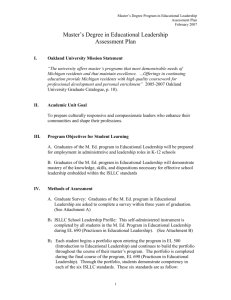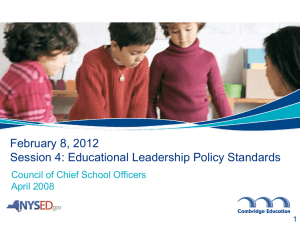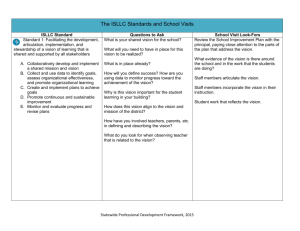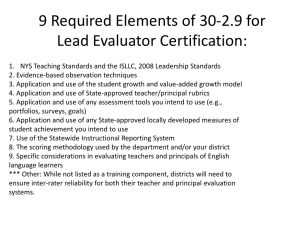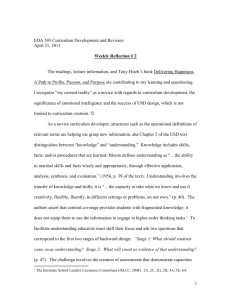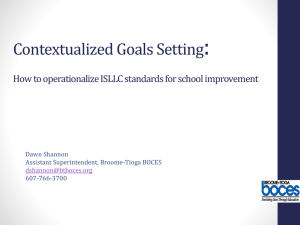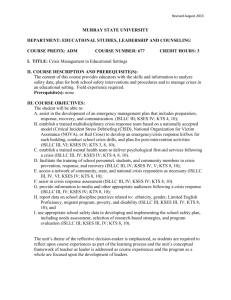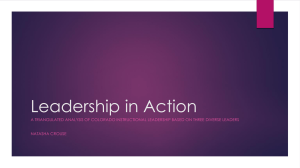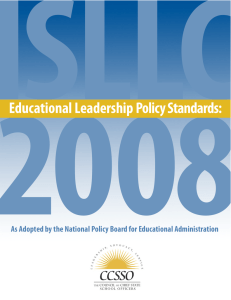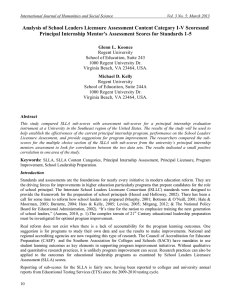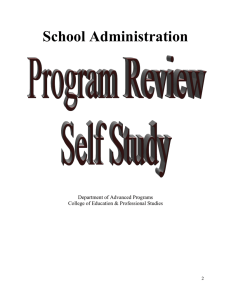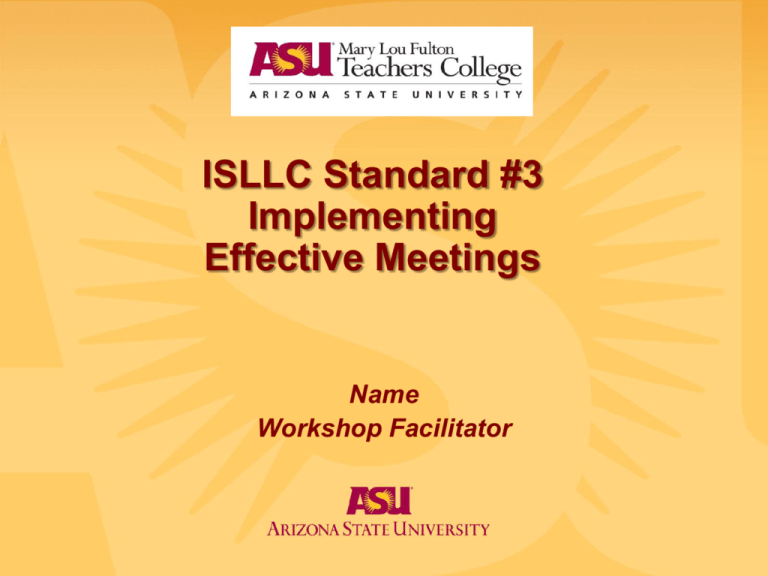
ISLLC Standard #3
Implementing
Effective Meetings
Name
Workshop Facilitator
Welcome
Name of Superintendent
Welcome
Why Important
© AZ Board of Regents, All rights reserved, 2012.
Overview & Introductions
Name of Facilitator
Introductions
Overview / Agenda
Guiding Questions
Targeted Objectives
ISLLC Standards
© AZ Board of Regents, All rights reserved, 2012.
Proposed Norms & Expectations
Stay focused and fully engaged
no competing conversations please
Participate to grow
share openly and monitor your listening
Be a learner
create your own meaning and application
Get your needs met
ask questions that benefit the group
personal questions on breaks
Housekeeping
silence cell phones
handle business later
share ONE point …then next person
Leadership Model
A Systems Thinking Approach: ISLLC Standards and
improvement strategies are managed through Key Processes
Implementing
Planning
Monitoring
Student
Achievement
Teacher Quality
Instructional
Leadership
Advocating
Supporting
Communicating
ISLLC Standards
A principal may choose to implement specific strategies to meet
the ISLLC Standards and/or improve his/her performance relevant
to the ISLLC Standards. The standards are:
1. Facilitating the development, articulation, implementation,
and stewardship of a vision of learning
2. Advocating, nurturing, and sustaining a school culture and
instructional program conducive to student learning and staff
professional growth
3. Ensuring management of the organization, operation, and
resources for a safe, efficient, and effective learning
environment
4. Collaborating with faculty and community members,
responding to diverse community interests and needs, and
mobilizing community resources
5. Acting with integrity, fairness, and in an ethical manner
6. Understanding, responding to, and influencing the political,
social, economic, legal, and cultural context
Sample Application Focus
ISLLC Standard #1: An education leader promotes the success of every student by facilitating the development, articulation, implementation, and stewardship of a vision of learning that is shared
and supported by all stakeholders”
ISLLC Element, Criteria,
or Targeted Behavior:
Current Reality
(include evidence)
Ideas/Strategies
to apply
Next Steps
What additional data do you need?
Who will you involve in process?
What resources do you need?
My Application Focus
Do WHAT?
By WHEN?
Aligning vision, mission, & goals [including
collecting data and using data identify need
and establish goals]
Collecting evidence of shared vision,
mission, & goals [including data on share
commitment and aligned behaviors]
Aligning professional development with
student needs and school improvement
planning [including systems thinking
approach to verify alignment of leadership]
What ideas, strategies, and/or concepts presented/discussed
in this professional development provided reinforcement for
things you already do well?
What ideas, strategies, and/or concepts presented/discussed in What is the projected impact
this professional development may address refinement for growth to teacher quality and
in your leadership role?
student achievement?
Application Focus
• At the conclusion of this module you will
identify key concepts and plan your
application focus
• In the column labeled “Current Reality”
– Rate yourself on a scale of 1-5
5 = Highly effective
3 = Satisfactorily Effective
1 = Ineffective
– Describe the evidence that supports your
application of this concept
ISLLC Standard 3 Workshop Objectives
Participants will:
Identify steps necessary to implement effective
and meaningful meeting procedures.
ISSLC Standard #3
Segment Guiding Question
As a school leader what procedures
can you implement to ensure that
meetings on your campus are
effective and productive?
What are the Characteristics of an
Effective Meeting?
With a partner think of your experience with
meetings and
Brainstorm the characteristics of the “good
meetings”
Discuss why effective meetings are important to
a positive school climate.
Video Clip
How to Lead a Meeting That People Enjoy
Attending
http://www.youtube.com/watch?v=b1QWPTYTC
yo
As you watch and consider…
What are the steps in the meeting process?
At the end of the meeting what do the
participants need to know?
Engaging staff in Effective Meetings
Handout: Article #1—Conducting Effective Meetings (The Community
Tool Box—ctb.ku.edu)
Handout: Article #2—Focus on Learning to Improve Your Meetings
(Classroom Leadership, June 2004: Vol. 7, Num. 9)
As you read the articles consider the following
question:
How can you engage staff in meetings and the
meeting process to make meetings meaningful
for the participants?
Engaging staff in Effective Meetings
As a table group discuss:
What you can do on your campus to engage
staff more effectively in the meeting process.
Do you currently incorporate any of the meeting
types outlined in the “Focus on Learning”
article?
Could these concepts be incorporated in your
current meetings, replace current less
meaningful meetings or added to the meeting
schedule?
Meeting Planning Form
Handout: Meeting Planning Form
Review the Meeting Planning Form
Identify any changes you would make to this
form to make it effective for your school.
Use the form to plan an up-coming meeting.
Application Focus
Consider the guiding question, and think
about connects between the ISSLC
Standard and workshop’s key concepts
Use column labeled “Strategies/Ideas”
List at least THREE things per box
Pair Share ONE strategy you learned today
and how you plan to use it at your school.
16
Workshop Closure
Review the following…
Targeted Objectives
ISLLC Standard (Elements, Criteria, or
Targeted Behavior list on Application Focus)
Next Steps
What additional data do you need?
Who will you involve in process?
What resources do you need?
Application Focus
Do what?
By when?
Workshop Closure
Please complete “Participant Feedback” form
Grant research
Improve future workshops

